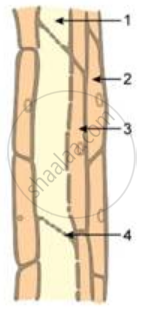Advertisements
Advertisements
प्रश्न
What are different types of tissues in plants? Describe simple tissues.
उत्तर
Plant tissues are divided into two broad categories:
(i) Meristematic tissue: It is further subdivided into apical, lateral, and intercalary meristems.
(ii) Permanent tissue: They are of two types.
(a) Simple permanent tissues include parenchyma, collenchyma, and sclerenchyma.
(b) Complex tissues include xylem and phloem.
Simple Tissue:
These tissues are composed structurally and functionally of similar cells. They are of three types.
(i) Parenchyma:
It is widely distributed in plant bodies such as stems, roots, leaves, flowers, and fruits. Its cells are isodiametric and contains live protoplasm. It serves as a food storage and packing tissue. It also stores waste products of plants.
(ii) Collenchyma:
The cells of collenchyma are located below the epidermis of dicotyledon stem and petiole. It consists of living cells and is characterised by the deposition of extra cellulose at the corners of the cell. It is a mechanical tissue in young plants. It also provide elasticity to the plant, particularly stem of dicots.
(iii) Sclerenchyma:
It consists of dead lignified cell. The sclerenchyma is mainly mechanical and protective in function.It occurs in abundance or in patches in definite layers in stems, roots, veins of leaves, hard covering of seeds, and nuts. It provides mechanical support to the plant.
APPEARS IN
संबंधित प्रश्न
How many types of elements together make up the xylem tissue? Name them.
Identify the type of tissue in the vascular bundle.
Draw a well labelled diagram of xylem.
What is the differences between collenchyma and sclerenchyma?
What do you know about complex tissue? Classify and explain its different types in plants with suitable diagrams.
Study the diagram given below and then answer the question that follows:

Name the parts labelled 1, 2, 3 and 4.
Give the structure and function of the following:
Collenchyma
The question has four answers. Choose the correct answer:
Phloem parenchyma, sclerenchyma, sieve tubes, and companion cells are found in
What are sieve tubes? Explain.
Cells of this tissue are living and show angular wall thickening. They also provide mechanical support. The tissue is ______.
